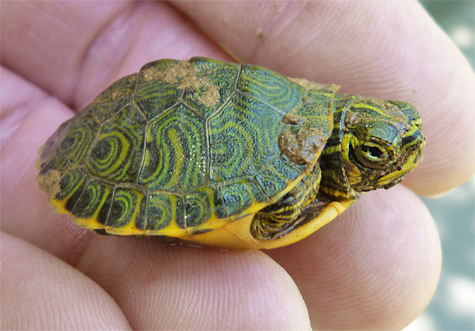I never pass the wetlands without giving a look into the water to see what’s about. There’s always something to see, some expected, like basking turtles, others are quite unexpected. Here’s a handfull of sights from Thursday (5/9).
The early season dragonflies emerged late this year. Common Baskettails typically become apparent in March. I didn’t seem them until April this year. They’re still flying.
Baskettails belong to a family of dragonflies most of whom, if not all, have green eyes when they reach maturity. The one pictured below was on patrol just below the boardwalk near the entrance to the Black Bear Exhibit. The ode hovered in one place for several seconds before dashing out to catch an insect or chase away a rival.



While watching the baskettail zip around below me I noticed a shiny object on a root stalk floating in the water. It was a Giant Water Bug.


The water bug above is obviously a male since it would have been a female that deposited the eggs on its back. The male provides both protection and a steady flow of fresh water over the eggs, when its submerged, that is. These insects bite when annoyed, so handle with care.
While in the boat checking the Wood Duck nest box two weeks ago, I noticed thousands, probably millions, of tiny fry in the water, shiner fry. Our resident Golden Shiner eggs have hatched. Again this Thursday while staring down at the dragonfly and water bug, the fry seemed to be everywhere. This is good news for just about every other creature in our Wetlands. Everything from dragonfly larvae, frogs, snakes, mergansers, kingfishers, herons, and even the occasional visiting otter eat the fish.

Elsewhere, there were several hatchling sliders out basking. Over the past few weeks there have been numerous sightings of the little turtles making their way from last year’s nests to the Wetlands. It’s good to see some of them have made it safely to their destination and are taking advantage of the sunny weather.

One turtle was rescued from the restrooms across from the Cafe. A Museum visitor found the turtle crawling around on the floor of the restroom, turned it over to Jerry (Exhibits), who handed it off to me, who placed it in the water in Explore the Wild.


Last year an adult slider was seen searching the Cafe Plaza area for a nesting location. It settled into the shrubs along the entrance to the Train Station. Our little “restroom” slider was probably one of her offspring.
And finally, there have been many, many turtles out basking since the return of the sunshine (we’ve had a lot of cloudy, rainy days lately). Here’s a parting shot of a small group of some of those sun worshipers in action.

Enjoy!
Do snappers prey on other turtles?
Their diet consists of aquatic invertebrates, small vertebrates (that includes young of larger vertebrates), plants, and carrion. They eat just about everything, so small turtles that swim in front of their faces will probably be snatched up. From what I’ve observed in our Wetlands it seems that their tactics are mostly ambush or the flushing of prey. I see them (the snappers) slowly moving through the water apparently hoping to flush prey from the vegetation, under logs, or other underwater objects, and with a very rapid jab with their long neck, grab the prey.
I don’t think though, that any turtle over a year or two has to worry about being eaten by a snapper. And, I don’t think that the snappers actually stalk any specific prey. Now, the Alligator Snapping Turtle is another story entirely….
Thanks,